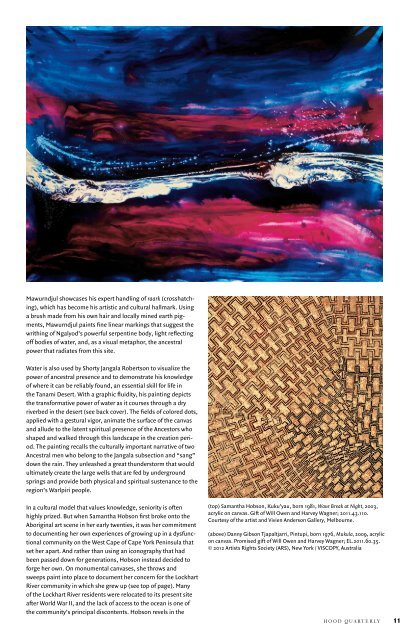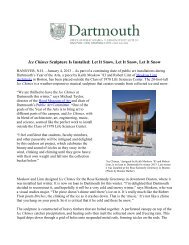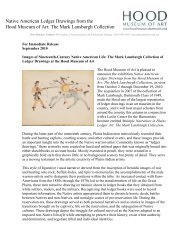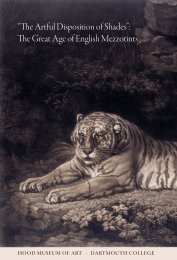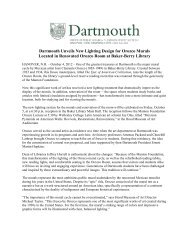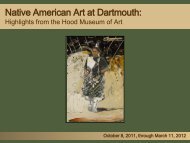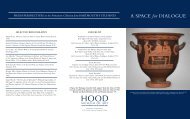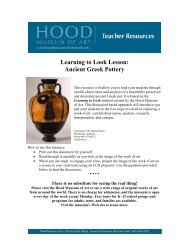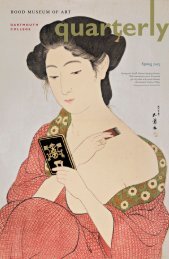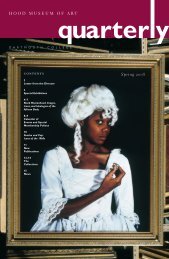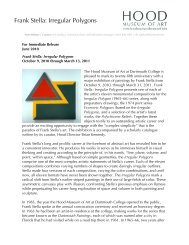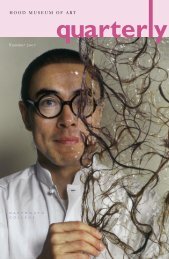Fall 2012 - Hood Museum of Art - Dartmouth College
Fall 2012 - Hood Museum of Art - Dartmouth College
Fall 2012 - Hood Museum of Art - Dartmouth College
You also want an ePaper? Increase the reach of your titles
YUMPU automatically turns print PDFs into web optimized ePapers that Google loves.
Mawurndjul showcases his expert handling <strong>of</strong> raark (crosshatching),<br />
which has become his artistic and cultural hallmark. Using<br />
a brush made from his own hair and locally mined earth pigments,<br />
Mawurndjul paints fine linear markings that suggest the<br />
writhing <strong>of</strong> Ngalyod’s powerful serpentine body, light reflecting<br />
<strong>of</strong>f bodies <strong>of</strong> water, and, as a visual metaphor, the ancestral<br />
power that radiates from this site.<br />
Water is also used by Shorty Jangala Robertson to visualize the<br />
power <strong>of</strong> ancestral presence and to demonstrate his knowledge<br />
<strong>of</strong> where it can be reliably found, an essential skill for life in<br />
the Tanami Desert. With a graphic fluidity, his painting depicts<br />
the transformative power <strong>of</strong> water as it courses through a dry<br />
riverbed in the desert (see back cover). The fields <strong>of</strong> colored dots,<br />
applied with a gestural vigor, animate the surface <strong>of</strong> the canvas<br />
and allude to the latent spiritual presence <strong>of</strong> the Ancestors who<br />
shaped and walked through this landscape in the creation period.<br />
The painting recalls the culturally important narrative <strong>of</strong> two<br />
Ancestral men who belong to the Jangala subsection and “sang”<br />
down the rain. They unleashed a great thunderstorm that would<br />
ultimately create the large wells that are fed by underground<br />
springs and provide both physical and spiritual sustenance to the<br />
region’s Warlpiri people.<br />
In a cultural model that values knowledge, seniority is <strong>of</strong>ten<br />
highly prized. But when Samantha Hobson first broke onto the<br />
Aboriginal art scene in her early twenties, it was her commitment<br />
to documenting her own experiences <strong>of</strong> growing up in a dysfunctional<br />
community on the West Cape <strong>of</strong> Cape York Peninsula that<br />
set her apart. And rather than using an iconography that had<br />
been passed down for generations, Hobson instead decided to<br />
forge her own. On monumental canvases, she throws and<br />
sweeps paint into place to document her concern for the Lockhart<br />
River community in which she grew up (see top <strong>of</strong> page). Many<br />
<strong>of</strong> the Lockhart River residents were relocated to its present site<br />
after World War II, and the lack <strong>of</strong> access to the ocean is one <strong>of</strong><br />
the community’s principal discontents. Hobson revels in the<br />
(top) Samantha Hobson, Kuku’yau, born 1981, Wave Break at Night, 2003,<br />
acrylic on canvas. Gift <strong>of</strong> Will Owen and Harvey Wagner; 2011.43.110.<br />
Courtesy <strong>of</strong> the artist and Vivien Anderson Gallery, Melbourne.<br />
(above) Danny Gibson Tjapaltjarri, Pintupi, born 1976, Mukula, 2009, acrylic<br />
on canvas. Promised gift <strong>of</strong> Will Owen and Harvey Wagner; EL.2011.60.35.<br />
© <strong>2012</strong> <strong>Art</strong>ists Rights Society (ARS), New York / VISCOPY, Australia<br />
HOOD QUARTERLY 11


